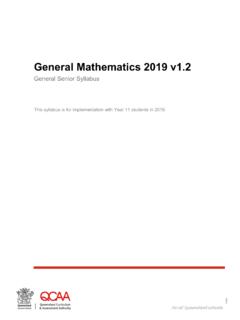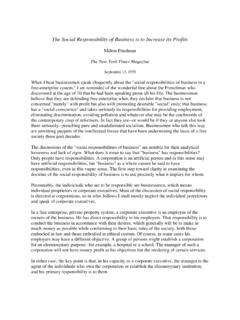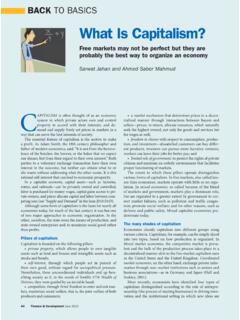Transcription of Applied Statistics and Econometrics: Notes and Exercises
1 Birkbeck Department of Economics, Mathematics and Statistics Graduate Certi cates and Diplomas Economics, Finance, Financial Engineering;. BSc FE, ESP. 2009-2010. Applied Statistics and Econometrics Notes and Exercises Ron Smith Email CONTENTS. PART I: COURSE INFORMATION. 1. Aims, readings and approach 2 Class Exercises 3. Assessment 4. How to do your project PART II: Notes . 5. Introduction 6. Descriptive Statistics 7. Economic and Financial Data I: Numbers 8. Applied Exercise I: Ratios and descriptive Statistics 9. Index Numbers 10. Probability 11. Discrete Random Variables 12. Continuous Random Variables 13. Economic and Financial Data II: Interest and other rates 14. Applied Exercise II: Sampling distributions 15.
2 Estimation 16. Con dence Intervals and Hypothesis Tests for the mean 17. Bivariate Least Squares Regression 18. Matrix Algebra & Multiple Regression 19. Properties of Least Squares estimates 20. Regression Con dence Intervals and Tests 21. Economic and Financial Data III: Relationships 22. Applied Exercise III: Running regressions 23. Dynamics 24. Additional matrix results 25. Index 2. 1. PART I: Course Information Aims Economists have been described as people who are good with numbers but not creative enough to be accountants. This course is designed to ensure that you are good with numbers; that you can interpret and analyse economic and nan- cial data and develop a critical awareness of some of the pitfalls in collecting, presenting and using data.
3 Doing Applied work involves a synthesis of various elements. You must be clear about why you are doing it: what the purpose of the exercise is ( forecasting, policy making, choosing a portfolio of stocks, answering a particular question or testing a hypothesis). You must understand the characteristics of the data you are using and appreciate their weaknesses. You must use theory to provide a model of the process that may have generated the data. You must know the statistical methods, which rely on probability theory, to summarise the data, in estimates. You must be able to use the software, spreadsheets, that will produce the estimates. You must be able to interpret the Statistics or estimates in terms of your original purpose and the theory.
4 Thus during this course we will be moving backwards and forwards between these ele- ments: purpose, data, theory and statistical methods. It may seem that we are jumping about, but you must learn to do all these di erent things together. Part I of this booklet provides background information: reading lists; details of assessment (70% exam, 30% project) and instructions on how to do your project. Part II provides a set of Notes . These include Notes on the lectures, Notes on economic and nancial data, and Applied Exercises . Not all the material in this booklet will be covered explicitly in lectures, par- ticularly the sections on economic and nancial data. But you should be familiar with that material. Lots of the worked examples are based on old exam questions.
5 Sections labelled background contain material that will not be on the exam. If you have questions about these sections raise them in lectures or classes. If you nd any mistakes in this booklet please tell me. Future cohorts of students will thank you. Rough Lecture Outline These topics roughly correspond to a lecture each, though in practice it may run a little faster or slower. AUTUMN. 3. 1. Introduction 2. Descriptive Statistics 3. Index Numbers 4. Probability 5. Random Variables SPRING. 1. The normal and related distributions 2. Estimation 3. Con dence Intervals and Hypothesis Tests 4. Bivariate Least Squares Regression 5. Matrix Algebra & Multiple Regression 6. Properties of Least Squares estimates 7. Tests for regressions 8.
6 Dynamics 9. Applications 10. Revison Tutorial Classes run through the spring term, doing the Exercises in section 2. The sections in the Notes on Economic and Financial Data and Applied Exer- cises, will be used for examples at various points in the lectures. You should work through them, where they come in the sequence in the Notes . This material will be useful for class Exercises , exam questions and your project. Learning Outcomes Students will be able to demonstrate that they can: Explain how measures of economic and nancial variables such as GDP, un- employment and index numbers such as the RPI and FTSE are constructed, be aware of the limitations of the data and be able to calculate derived sta- tistics from the data, ratios, growth rates, real interest rates etc.
7 Use a spreadsheet to graph data and calculate summary Statistics and be able to interpret the graphs and summary Statistics . Use simple rules of probability involving joint, marginal and conditional probabilities, expected values and variances and use probabilities from the normal distribution. 4. Explain the basic principles of estimation and hypothesis testing. Derive the least squares estimator and show its properties. Interpret simple regression output and conduct tests on coe cients. Read and understand articles using economic and nancial data at the level of the FT or Economist. Conduct and report on a piece of empirical research that uses simple statis- tical techniques. Your input To achieve the learning outcomes (and pass the exams) requires a lot of indepen- dent work by you.
8 We will assume that you know how to learn and that there are things that we do not have to tell you because you can work them out or look them up for yourself. The only way to learn these techniques is by using them. Read these Notes . Get familiar with economic and nancial data by reading newspapers (the FT is best, but Sunday Business sections are good), The Economist, etc. In looking at articles note how they present Tables and Graphs; what data they use; how they combine the data with the analysis; how they structure the article. You will need all these skills, so learn them by careful reading. Ensure that you can use a spreadsheet, such as Excel. Try to attend all lectures and classes, if you have to miss them make sure that you know what they covered and get copies of Notes from other students.
9 Do the Exercises for the classes in the Spring term in advance. Continuously review the material in lectures, classes and these Notes , working in groups if you can. Identify gaps in your knowledge and take action to ll them, by asking questions of lecturers or class teachers and by searching in text books. We are available to answer questions during o ce hours (posted on our doors). or by email. 5. Do the Applied exercise (section 8 of the Notes ) during the rst term. We will assume that you have done it and base exam questions on it. Start work on your project early in the second term, advice on this is in section 4. Reading There are a large number of good text books on introductory Statistics , but none that exactly match the structure of this course.
10 This is because we cover in one year material that is usually spread over three years of an undergraduate degree: economic and nancial data in the rst year, Statistics in the second year, and econometrics in the third year. Use the index in the text book to nd the topics covered in this course. These Notes cross-reference introductory Statistics to Barrow (2009) and the econometrics and more advanced Statistics to Verbeek (2008). This is one of the books that is used on the MSc in Economics econometrics course. There are a large number of other similar books, such as Gujarati and Porter (2009) and Stock and Watson (2009). There are a range of interesting background books on probability and sta- tistics. The history of probability can be found in Bernstein (1996), which is an entertaining read as are other general books on probablility like Gigerenzer (2002), and Taleb (2004, 2007).







